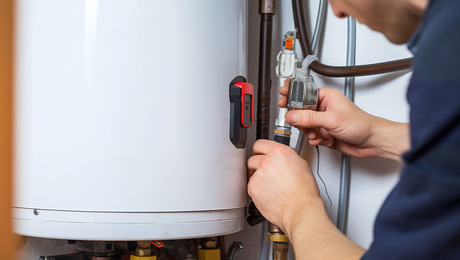I know this isn’t generally recommended, but I have a 18″ floor system above this bathroom and a 30″ deep soffit, so I have lots of room to run the vent without constricting it. Question is what do I use to terminate it in the soffit and how do I keep outside air from coming all they way back to the butterfly damper on the interior unit? Or is that just the way it is and I shouldn’t worry about it? I guess I could use flexible insulated duct for the inside run.
Thanks -MERC


















Replies
Is this just a fart fan in a half bath or is it a full bath with shower thats going to seem some moisture build up?
Why the soffit?
with the 18" floor above it sounds like this the first floor of a 2 story house, Just vent out the side wall.
Sure ,you can put the vent into the soffit, in fact, other than a sidewall , it 's the next best place to put it. It sure beats puncturing thru the roof, etc..... just make sure you install the back-draft flapper at the soffit line (these are special made "T" style flappers.) they work great. A soffit installation is best because the termination point is out of the weather, cannot get snow jammed, or rained on, and cannot flap noisily in a high-wind like the roof mounted ones do. Good luck Hube
But can suck the moisture right into the attic through the soffit attic venting.
How can it ,as you say suck the moisture from the attic if its entirely pipe connected from the soffit termination point to the ceiling grille. Your so-called logic makes no sense
I think you misunderstood him. The moisture from the fan will be sucked into the attic via the soffit vents. The natural draft will cycle the moist, warm air into the attic and potentially cause a mold/mildew problem.
I never met a tool I didn't like!
I said suck the moisture INTO the attic.
If you have a properly ventalated attic with soffit vents and ridge vents then you will have a constant stream of air moving from the soffit vents to the ridge.
Then if you have an bath fan terminating on the soffit there is a good chance that the exhausted moisture will be drawn into the attic.
Bill; i understand what your claiming.
But this air is being exhausted at a fair speed (approx 60-100 cfm) DOWNWARD, and AWAY from the soffit pores. By the time this exhausted air is mixed and diluted with any surrounding air, it will be quite alright to enter into the soffit area.
They make a roof vent with a flapper,even though you have to cut a hole in the roof and flash it you really want to get the moist air outside . You will never kick yourself for doing it right.
If you're that concerned about it, just don't put any soffit vents near the fan exhaust port (or block any continuous soffit vents near the port).
Is this the soffit termination that you are talking about:
http://www.fantech.net/accessories4.htm
See "UEV 4" about halfway down the page.
As far as going to a sidewall, I could do that but I don't want to because it's the street facing gable and I don't want that to look like crap. I could go to another sidewall but that run is 20' or so, when the gable soffit can be had for almost nothing.
The fan is going to be for a guest bathroom, so long term moisture isn't a huge concern, but no sense in not dropping it all the way to the soffit.
I like the point about drawing moisture right back into the attic, except I don't have one. I have no real walls on the second story, just a 12/12 roof down to the floor system. I plan on making all that space unvented cathedral ceiling using polyurethane foam spray insulation.
MERC.
Sorry on a gable end you won't any soffit vents anyway. And if it is an unvented roof then it would not be a problem even if it was not on the gable end.
Yep, the UEV 4 will do the job. The power of the fan force will "throw" the exhausted air 'down and away' from re-entering immediately. Of course new air will come back into the soffit, but it will not be the moist exhausted air.